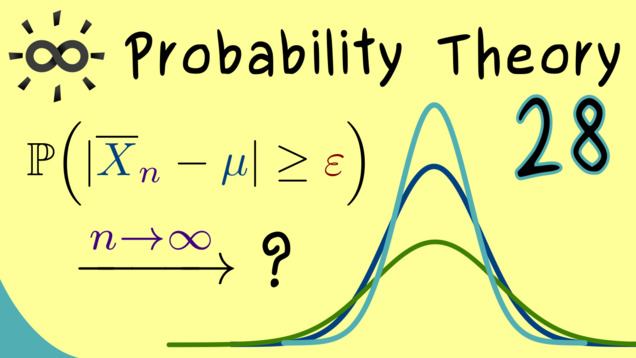
-
Title: Weak Law of Large Numbers
-
Series: Probability Theory
-
YouTube-Title: Probability Theory 28 | Weak Law of Large Numbers
-
Bright video: https://youtu.be/wMH1muP-mAI
-
Dark video: https://youtu.be/2Hd_xXM8T3Y
-
Quiz: Test your knowledge
-
Dark-PDF: Download PDF version of the dark video
-
Print-PDF: Download printable PDF version
-
Thumbnail (bright): Download PNG
-
Thumbnail (dark): Download PNG
-
Subtitle on GitHub: pt28_sub_eng.srt missing
-
Timestamps (n/a)
-
Subtitle in English (n/a)
-
Quiz Content
Q1: What does it mean that a family of random variables is i.i.d?
A1: It means that they are independent and identically distributed.
A2: It means that they are independent and identically defined.
A3: It means that they are identically distributed and intelligent.
A4: It means that they are intrinsically independent distributed.
Q2: Let $X_k: \Omega \rightarrow \mathbb{R}$ be a random variable where $\mathbb{E}(|X_1|)$ exists. What is the correct statement for the weak law of large numbers?
A1: If $(X_k){k \in \mathbb{N}}$ are i.i.d., then $$ \mathbb{P}\left( \Big| \frac{1}{n} \sum{k = 1}^n X_k - \mathbb{E}(X_1) \Big| \geq \varepsilon \right) \xrightarrow{n \rightarrow \infty} 0 $$
A2: If $(X_k){k \in \mathbb{N}}$ are i.i.d., then $$ \mathbb{P}\left( \Big| \frac{1}{n} \sum{k = 1}^n X_k - \mathbb{E}(X_1) \Big| = \varepsilon \right) \xrightarrow{n \rightarrow \infty} 0 $$
A3: If $(X_k){k \in \mathbb{N}}$ are i.i.d., then $$ \mathbb{P}\left( \Big| \frac{1}{n} \sum{k = 1}^n X_k - \mathbb{E}(X_1) \Big| \leq \varepsilon \right) \xrightarrow{n \rightarrow \infty} 0 $$
A4: If $(X_k){k \in \mathbb{N}}$ are i.i.d., then $$ \mathbb{P}\left( \Big| \frac{1}{n} \sum{k = 1}^n X_k - \mathbb{E}(X_1) \Big| \leq \varepsilon \right) \xrightarrow{n \rightarrow \infty} \frac{1}{\varepsilon} $$
-
Last update: 2024-10